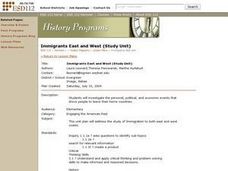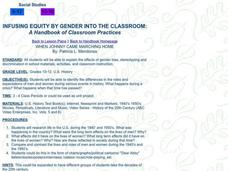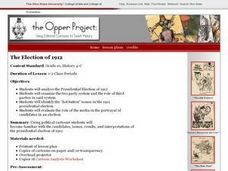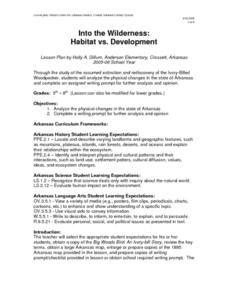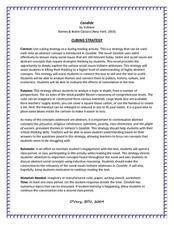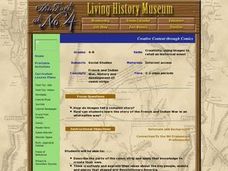Curated OER
The First Ladies
High schoolers compare two First Ladies. In this American history lesson, students read speeches given by Barbara Bush and Hillary Rodham Clinton. High schoolers respond to questions about the speeches.
Curated OER
Immigrants East and West
Students investigate the personal, political and economic events that drove people to leave their home countries. They research Chinese migrations in the 1800s and the English migrations in the 1600s. They create an identity based on...
Gilder Lehrman Institute of American History
Women's Suffrage: 140 Years of Struggle
Young scholars create PowerPoint presentations about women's suffrage. In this women's rights instructional activity, students use primary documents to study the women's suffrage movement. In pairs, young scholars create a PowerPoint...
Curated OER
WHEN JOHNNY CAME MARCHING HOME
Students examine the roles of men and women throughout history.
Curated OER
The Cost of Progress
Students examine the cost of progress from the 1500's to the 1800's around the world and create informative websites based upon their research. This instructional activity is intended for a high school World History class and uses the...
Curated OER
What is the Character of Maine?
Young scholars create an individual portfolio using assignments from a unit on the character of Maine. They choose two of the best assignments from each of four chapters studied and then write an essay or create a magazine which...
Curated OER
Genetic Engineering
Students identify relationships between scientific concepts and their historical roots. They discuss and debate issues of ethics in science, specifically on the concept of genetic engineering and describe the processes of cloning and...
City University of New York
Women's Suffrage and World War I
Democracy cannot exist where not everyone has equal rights. Discuss the state of democracy and women's suffrage during World War I with class discussions, debates, and primary source analysis, in order for class members to connect with...
Curated OER
Book: Crossing the Seas
As learners read each chapter of Eric Schwartz's Crossing the Seas, they analyze the actions of United States in Venezuela, Hawaii, Cuba, the Philippines, Puerto Rico, and the intent of the Monroe Doctrine. They then compare American...
Barren County Schools
American Revolution Project
Here you will find three simple and engaging American Revolution projects that will allow your learners to not only express their comprehension of major events and key terms during the war, but also offer the opportunity for great...
Curated OER
The Election of 1912
Tenth graders examine the Election of 1912. In groups, they identify the roles of the Democratic and Republican parties along with any third party mentioned. Using the internet, they describe the main issues of this election and discuss...
Curated OER
Treaty of Versailles
Students describe the purposes of the Treaty of Versailles. In groups, they analyze the causes and effects of the treaty and discuss why the Americans were so against it. They note ideas for and against its ratification and they make...
Curated OER
Multiple Perspectives on the Korean War
Students interpret historical evidence presented in primary and secondary resources. In this Korean War lesson, students examine and analyze primary sources regarding U.S. involvement in the Korean War.
Curated OER
Teaching with Poster Art: World War I Posters
Students interpret historical evidence presented in primary resources. In this World War I lesson, students examine World War I posters. Students investigate the use of propaganda strategies in the posters and discuss the visual metaphors.
Curated OER
A Day for Choosing Revolution
Young scholars read contemporary news articles about public protest. They describe a form of protest that took place in 18th-century Virginia. Students compare events or ideas that people protest about today to events or ideas protested...
Curated OER
Exploring Suffragists
Students engage in a conversation with the class about suffrage- the right to vote. They choose one specific suffragist and use the Internet and other reference materials to learn more about this person. They prepare a presentation to...
Curated OER
Into the Wilderness: Habitat vs. Development
By studying the once-assumed extinction, then rediscovery of the Ivory-Billed Woodpecker, learners look at the physical changes that have occured in habitats throughout Arkansas. This outstanding lesson is chock full of terrific...
New Class Museum
Lesson: Emory Douglas: Decoding Images and Vocabulary Activity
To better understand the work of Black Panther logo artist Emory Douglas, learners define literary devices. They define a series of words such as metaphor, simile, and assonance, then place an example of that device found in Emory...
Curated OER
Candide Cubing Strategy
Candide is a dense text. To assist in analyzing Voltaire's satire, groups employ a cubing strategy based on Bloom's taxonomy. Complete directions for the strategy, a template for the cube, a worksheet, and a topic list are included.
University of Wisconsin
Why Did the Triangle Fire Occur?
An investigation of the 1911 New York City Triangle Shirtwaist Factory fire leads class members to examine primary and secondary source materials related to the event and apply what they learn about the working conditions at the time to...
Curated OER
OPEC and the Energy Crisis
Learners color the Middle East Nations of OPEC on outline maps. They discuss and watch a video about the United States reliance on oil producing nations of the Middle East. They participate in a discussion of the problems of the gas...
Curated OER
Seeking Civil Rights
Students explore the impact of the Plessy v. Ferguson case. For this social justice lesson, students examine the case, Jim Crow laws, and non-violent forms of protest. Students write essays to persuade the government regarding unjust laws.
Curated OER
Creative Content through Comics
Students identify the different parts of a comic strip and creat their own about the French and Indian War period. They share their comics with the class. They can compile them into a newspaper format if they choose.



